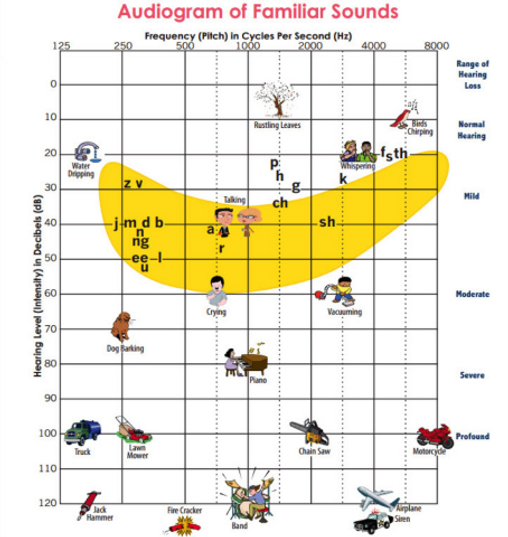Test Results
If the results of the diagnostic test show your baby has a hearing difference, you are not alone. There are many supports and resources available to you, your family, and your child.
You will be learning more about your child's hearing difference in the coming months. Here are some basics you’ll want to know about the information you may receive from the audiologist.
Degrees of Hearing Differences
Slight Difference 15-25 dB
A child can miss 25-40% of speech sounds. May have difficulty hearing soft speech and conversations but can manage in quiet places.
Mild Difference 26-40 dB
A child can miss 25-40% of speech sounds. May have difficulty hearing soft speech and conversations but can manage in quiet places.
Moderate Difference 41-55 dB
A child will miss 50-75% of spoken language, especially if there is background noise. Speech and language will be delayed without early intervention.
Moderate to Severe Difference 56-70 dB
A child with a difference over 56dB will miss up to 100% of speech sounds. Early intervention is important as there is a high risk for major delays in talking and understanding spoken language.
Severe Difference 71-90 dB
A child will miss 50-75% of spoken language, especially if there is background noise. Speech and language will be delayed without early intervention.
Profound Difference 91 dB or more
A child will miss 50-75% of spoken language, especially if there is background noise. Speech and language will be delayed without early intervention.
What is an Audiogram?
An audiogram is a graph of the softest levels at which your child can access sound. It is a picture of the results of the hearing tests that are done by an audiologist. The audiogram will show two things: intensity and frequency. Intensity (loudness) is measured in decibels (dB) and frequency (pitch) is measured in Hertz (Hz). If your child is diagnosed with a hearing difference, it is important to understand the level sound-access along with the implications for speech and language. This will help you access the services and therapies that your child may need. By learning to read your child’s audiogram, you are empowering yourself as a parent and becoming your child’s biggest advocate!
The audiogram bellow, commonly known as the "Speech Banana" is a helpful diagram of the different levels of sound thresholds, and what common sounds lie within them. To better understand the audiogram, plase keep reading.

How to Read an Audiogram
-
Decibels (dB): The numbers that are located on the left side of an audiogram and range from -10 at the top (the softest sounds) to 120 on the bottom (the loudest sounds). They represent sound intensity or loudness. A mark on the audiogram at 50 dB means that your child did not respond to the sound until it was as loud as 50 dB.
-
Hertz (Hz): The numbers that are either at the top or bottom of an audiogram represent pitch or frequency. Just like a piano’s keyboard, the pitches range from very low on the left side to very high on the right side. Your child’s hearing will be tested at each frequency and a mark on the audiogram noted for how loud each sound must be for your child to hear it. This mark can change from ear to ear and across the frequency scale.
-
Keep in Mind: An audiogram gives you an idea of what your child hears in a very quiet environment and should not be interpreted as what your child may hear every day under normal, busy and noisier circumstances. Tell the audiologist if you have any concerns.
Abbreviations to Know
-
AC: air conduction
-
AD: right
-
AS: left
-
BC: bone conduction
-
CNT: could not test
-
DNT: did not test
-
HA: hearing aid
-
HL: hearing level
-
NR: no response
-
SAT: speech awareness threshold
-
SRT: speech reception threshold
-
WNL: within normal limits

